






Peyton Kuschmeider
Saahir Mawani
Krista Fleming
Lily Andersson
Hannah Mathew
Siya Patel
The Hawk Eye magazine is an official publication of Hebron High School. It is a student-produced magazine which strives to represent the student voice. We will aim to report all news relevant to Hebron High School and its student body without bias to race, religion or creed. Views expressed by columnists are their own personal opinions and do not necessarily represent the views of the entire staff. Editorials reflect the staff opinion and may not reflect the views of the school administration. We encourage reader input via letters and story ideas. Contact a staff member or fill out the contact form on our website, www.hebronhawkeye.com, with any of these items. The Hawk Eye is a member of Interscholastic League Press Conference, Texas Association of Journalism Educators, Association of Texas Photography Instructors, the Journalism Education Association and the National Scholastic Press Association.

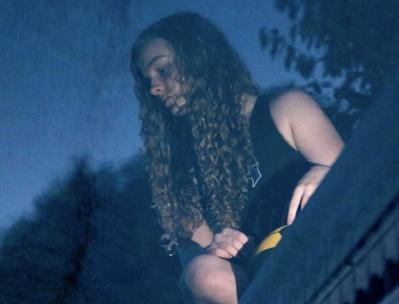
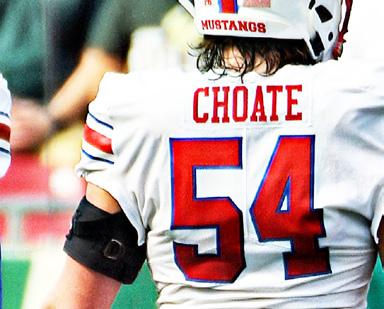
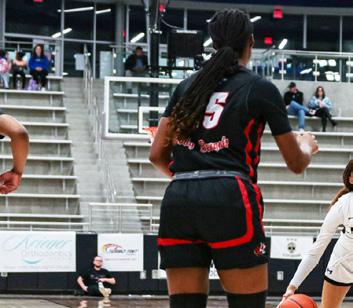
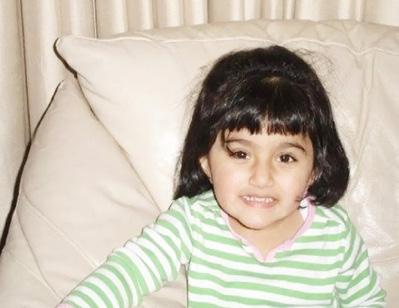



Story by SHiren noorani
Distributive Education Clubs of America (DECA) will compete in its State Career Development Conference March 6-8. The competition is being held at the Hilton Anatole in Dallas, rather than Houston, like last year. Hebron DECA has the most state qualifiers from any LISD delegation, with a school-record-breaking 89 competitors.
“We have the largest delegation from LISD going, which we’re very proud of,” DECA president Nisha Pandya said. “We’re telling everyone. It’s honestly such a huge accomplishment.”
“
It waS deFinitely diFFicult Figuring out tHe leVel oF comPetition tHat tHere would HaVe been, juSt becauSe we didn’t HaVe any StatiSticS For tHe newer ScHoolS
-niSHa Pandya, deca PreSident
DECA competitors can compete in role play or written competitions. The roleplay competition consists of an impromptu scenario that competitors must handle, while the written portion consists of a written report/essay submitted in advance and a presentation given the day of. Depending on the specific event, some competitors must score high enough on a multiple choice question test (MCQ) in order to advance to the next level. DECA’s 89 competitors are made up of 73 role play competitors and 16 written competitors.
“My partner and I, we look at performance indicators — like on Quizlet — and then [we] use DECA+ [to] look at practice role plays and be able to practice the different scenarios,” event coordinator Amy Ngo said. “But this year, we’re focusing heavily on studying for [the] MCQ, because testing is now in-person [and] on paper at state.”
This year, DECA faced a district change due to its original district, district seven, becoming too big and hav-
ing to split into two separate districts. Now, DECA qualifies under district 12 with the other LISD high schools, alongside newer schools from various school districts.
“When we were part of district seven, we knew the schools that we were competing against — the personalities [and] their overall scores,” Pandya said. “This year, we only knew some of the LISD schools [at the district level meet]. It was definitely difficult figuring out the level of competition that there would have been, just because we didn’t really have any of those statistics for the newer schools.”
Along with the district change, DECA Inc. changed what used to be on-campus testing to on-site testing for the state meet and increased the percentage of how much the MCQ counts toward one’s grade from 50% to 60%.
In addition to those changes, Hebron DECA decided to enforce a new rule this year: a student can only compete with DECA if they are in a career and technical education (CTE) class, but a student must be enrolled in a business-related CTE class to travel. The option of virtual competing, if in any CTE class, is only available this year, as it was meant to help ease the transition from only allowing those in business-related CTE classes from being a part of the club.
“I know [other schools] are still held to the same standard that you have to be in a business class to get LISD to pay for their portion of the travel, but I don’t know how they have applied it,” sponsor Jamie Leonard said. “It was in May that we found out that [this] requirement was coming out from LISD, and so at that point, course selection was done, there was not a lot we could change. In [the summer] we got
together with all of our board members so that we could plan the year, and that was when they came up with that idea [that you have to be in a business CTE course.] I just had to pitch it to the district, and they approved it.”
The first day of the three-day state meet consists of an opening ceremony, followed by the competition and testing day. The final day is when the awards ceremony takes place in which students will find out whether or not they qualified for the international meet April 26-29 in Orlando, FL.
“Hebron DECA is one of the biggest [delegations] internationally,” Pandya said. “Being able to compete at that level is such a huge accomplishment — 89 competitors is a huge number. We had over 70% of people qualify. Just being able to have that many seats taken up at state is amazing.”


Story by KriSta Fleming and lily anderSSon
Senior Hayden Riordan stared at the email in front of her.
“Let us know if you change your mind,” the coach had responded to her after she told him she would no longer be able to play water polo on the collegiate level. She wouldn’t even be able to finish her high school season.
The coach worded it like a choice; it still doesn’t feel like one.
Hayden played water polo for four years through club and school practices, where she obtained six concussions. She retired at the end of the season, and said it feels like mourning.
“[The pool] was like a second home to me,” Hayden said. “Now that I don’t go, it feels like I don’t have that second home. I don’t see that second family every day like I used to. I’m missing half of my life.”
Growing up, Hayden was always involved in sports. Her family valued physical activity, and her mom, Randi Riordan, encouraged Hayden to try out different sports until she found the one she loved. In fourth grade, Hayden joined her first competitive swim team and fell in love with swimming.
“I would get in the pool in my backyard in the dead of winter,” Hayden said. “My family thought I was crazy. The water is just calming [and] something about the waves makes me feel at home.”
She stayed in swim through eighth grade, but was becoming burnt out from the sport. Hayden enjoyed the competitive nature of swim, so Randi pushed her to join the water polo team in high school.
“I was terrified,” Hayden said. “[Water polo] is girls roughing each other up in the water. I kept thinking: Why on Earth would I want to do that?”
After encouragement from Randi and head water polo coach Donzie Lilly, Hayden joined the water polo team. Despite her fears, she quickly became obsessed with the sport.
“There’s something about racing a girl to the ball,” Randi said. “Whether you win or don’t win, it’s exhilarating. Watching her become so dedicated was all I could ask for as a mother.”
At her third practice of the year, Hayden was leaning on the side of the pool by the goal, idly talking to her friends while waiting for her turn on a drill. Then, a ball slammed into the back of her head. A ball thrown very hard by another player trying to make a goal.
“There was a weird fogginess in my head,” Hayden said. “My head didn’t feel right. I knew something was wrong.”
After seeing a doctor, her first concussion was confirmed, and Hayden had to sit out for the first game of the year.
“Being out made me want to be in even more,” Hayden said. “I had lost time to make up for and I wanted to make every second count once I was in.”
The second time shouldn’t have happened.
That’s what Randi will say when you ask her about her daughter’s car accident and second concussion. Hayden had been driving her 2001 Jeep Wrangler straight through an intersection, when a car began to turn toward her. The last thing she remembered clearly was honking the horn.
Everything else was a blur: the airbags went off. A child in the other car let out a piercing scream. She thought she was dreaming.
“It all sounded like I was underwater,” Hayden said. “Everything was hazy.”
She got out of the car and took a photo of the license plate of the car that hit her. She had a cut on her face from the airbag but wasn’t bleeding, and tried to talk to the other driver with as clear of a head as she could manage. A teammate’s mom recognized her as she drove past, and pulled over to help her. When Hayden saw the familiar face, her faux-calmness washed away.
“All the adrenaline left and I broke down,” Hayden said. “I just started crying and couldn’t stop.”

Between the high school seasons, Hayden played water polo for a club team. Last June, she was hit in the head during a club practice: her third concussion. That weekend, the team was supposed to attend a tournament, and Hayden decided to play despite the concussion.
“I don’t remember a lot of it,” Hayden said. “I had no clue what was going on in the middle of the game. I was freaking out. I couldn’t focus on what I was supposed to be doing, and I couldn’t multitask the way I had to.”
By the end of the first game, Hayden knew she needed to go home, but convinced herself that she was fine. She played on, not stopping for the whole tournament. The day after she got home, she had another club practice. Still recovering from the third concussion, Hayden was hit by a ball
She went to the locker room and called her mom.
“It was rough,” Hayden said. “My friends and sisters got to play what they loved in college, and I won’t be able to. It put me down a lot, and I kept spiraling when I thought about it.”
A few days and visits to the doctor later, she officially resigned from water polo.
“We saw [Hayden’s retirement] coming,” Lilly said. “It was always kind of on the horizon. We knew there was just one more concussion and then she’d be done for good.”
After three concussions, a student is supposed to stop high school athletics; Hayden and Randi knew this, but it did not stop them from wondering if things could get better. But concussions don’t show up on X-rays.

“When you send your kid to college, you’re just letting them go,” Randi said. “It’s easier when they have something to be a part of, because then they have a second family there. She doesn’t have that built in like she used to.”
Hayden plans to major in kinesiology, or exercise science. She said she doesn’t quite know what she wants to do with the degree, but is looking into becoming an athletic trainer and potentially coaching water polo on the side.
“A part of my love for water polo will still be with me,” Hayden said. “Even if I can’t play, I can coach. I can learn. I can do something to keep that love alive.”

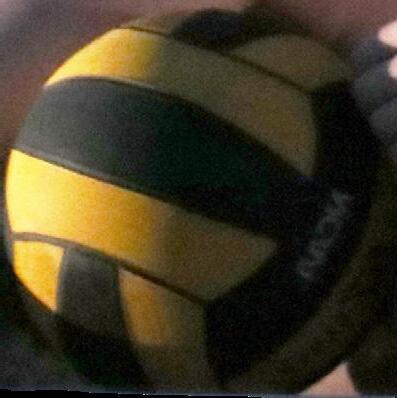



STORY BY PEYTON KUSCHMEIDER
“Do you want to have kids?”
At 21 years old, that was the question his college team’s doctor asked him, sitting in a room at Southern Methodist University (SMU).
“Yes.”
“In 10 years, do you want to be able to run with your kids?” The doctor asked.
The answer was obvious: of course he did. If that was true, his doctor told him he would have to stop playing football — the sport he had dedicated his life to. If he kept playing, he would eventually be unable to walk.
That was the moment defensive line coach Gerrit Choate decided to hang up his football jersey for good and turn to a new life path: coaching.
Choate played football at the University of Utah and SMU. His life goal had always been to go into the NFL, but after multiple serious injuries and permanent body damage, he was forced to medically retire. He decided to stay within athletics the only way he knew how and became a high school football coach.
Choate was always an athletic kid. At 6 months old, he was jumping around. At 2 years old, he was shooting basketballs into the hoop at his house. He started off playing basketball, and didn’t bother with football until middle school.
Choate’s father, Putt Choate, played college football at SMU and went into the NFL; it became his dream to follow in his father’s footsteps. Even though his parents didn’t want him playing at a young age, they eventually allowed him to put football pads on in the seventh grade.
“[At my] first practice ever, I was terrified,” Choate said. “I didn’t want to hit anybody. I thought I was going to throw up because I was so nervous. As it went on, I started to figure out that I was really good at it, and it became
more fun — I developed a love for the game.”
Within his first season playing football, he took a hit that fractured the L-5 vertebrae in his spine. He was told he would never be able to play sports again.
“When I fractured [my] vertebrae, that was a really hard time,” Choate said. “Luckily, I had great support to help me through [it,] because at that age, you don’t know how to take that and not let it defeat you.”
Choate was in a back brace for a year. His doctor told him that if he did everything they told him to, there was a chance he would be back on the field.
He couldn’t run, jump or underhand toss a ball for that year. He was not expected to be able to play again, but, by his eighth grade year, he was back in the game.
“My dad always told me that you will get hurt playing — it’s not if, it’s when and how bad,” Choate said. “I was never scared of getting hurt; I knew that it was going to happen at some point. You just have to go in there, give it your best and you deal with the consequences. You get hurt, you rehab and then you get back on the field.”
Throughout his football career, his parents were at every game. If his dad was out of town, he would fly in to watch the game and fly back the same night.
“[We] didn’t want to miss anything,” Choate’s mother, Fifi Choate, said. “We loved it. We were there for everything.”
Choate suffered multiple injuries and serious hits during his first few years playing football, which Fifi said was scary to watch.
“I could get past that [fear] because he was so happy,” Fifi said. “You can’t hold a kid back out of fear. You can’t live your life that way, and I realized my fears of him getting hurt can’t keep him from doing something that he is passionate about. It was hard, but as a parent you want your kids to be happy — there was more joy involved than fear.”
When Choate graduated high school, his dream was to go to SMU just like his father had. It was his goal to beat his father’s record as the leading tackler in SMU history.
He was rejected from the school. His dad played with the head coach at the University of Utah during his time in the NFL, so with that connection and an offer from the school, he enrolled as a walk-on there.
That only lasted a year.
“I started feeling sick,” Choate said. “I was exhausted all the time, completely, non-stop. Getting through practice was terrible. It was just hard. It became clear that something was wrong.”
When he started losing muscle mass, his parents grew concerned and took him to the hospital. There, they ran blood tests and genetic tests, which revealed that the anxiety medication he had been taking for the past 10 years was toxic to his genetic makeup. That’s what was making him feel sick.
“I already felt like I had been through so much because of [football,] and I just wanted to play,” Choate said. “It was a scary time; my body was suffering and it was because of a prescribed medication for anxiety that I had, and the worst part was that it wasn’t even my fault.”
His doctors told him that he would have to detox off of the medication fully. Since he was on it for so long, his body became completely dependent on it. For the second time in his career, he was told that he would never be able to play again.
“It was brutal because we couldn’t understand why this kept happening to him,” Fifi said. “Why was everything happening to him?”
He was given two options: be hospitalized for months or have a family member move to Utah to monitor him through the detox. Fifi moved to Utah.
“It was the easiest decision,” Fifi said. “We had an apartment in Utah
right down from the university, and we wanted him to have a place he could feel like was a home. When I needed to be there with him, it was easy to go.”
After a few months of recovery, Choate moved back to Dallas. He took online classes for a while, but struggled to stay focused due to the impact the detox had on his brain.
After recovery, he transferred to SMU, the school he had always wanted to go to, and walked-on to their football program.
“I wanted a fresh start because that [experience] was just tough,” Choate said. “I’m someone who believes everything happens for a reason, and that was almost like a door back into SMU. It was terrible, but it got me where I had always wanted to go.”
Choate played two seasons at SMU, and he had two years of eligibility left. Playing in the NFL was his dream, and he was on track to make it a reality.
Following the 2019 season, he began to notice unbearable pain in his feet during the off-season. He went to the doctor to get evaluated and learned that he had permanent overuse damage to his feet from playing football.
Just like every other injury, the goal was to take some time off and recover, but the pain persisted, and only grew worse.
He got a second and third opinion, yet it was ultimately decided that it would be in his best interest to quit playing before he did any more damage. If he kept playing, his feet could have become damaged enough to prevent him from walking — permanently. In the future, he will have to have reconstructive surgery performed on his feet.
“It was the most difficult point in my life,” Choate said. “That was harder than the medication, that was harder than the brace, because I knew it was over. I didn’t think about life after playing because that was down the line — I didn’t need to think about it — then, all of a sudden, here it is front and center.”
Choate knew he had to be a part of the game somehow. There was only one way he could think of to do that safely: coaching.
Choate first began coaching at Molina High School, where he coached for one year, before moving to Ranchview High School.
He still felt like he could elevate from those jobs, and knew if he was going to coach, he wanted to coach 6A football. That was when he saw the job opening at Hebron.
“When I saw it, I didn’t know if I was ready,” Choate said. “I didn’t know if I was ready to be coaching at such a high quality program that wins.”
He took a chance and applied anyway. After interviewing, he got the job.
Along with Choate, defensive backs coach Clayton Johnson was also hired at the same time. The two started during the summer and bonded over the fact that they were the two youngest coaches on staff.
“It was comfortable,” Johnson said. “We didn’t know what to expect [when] we came in together, [but] we came in with the same goal and the same mindset to elevate this program and win games.”
They soon became close friends, sighing in relief together when they won games and jumping up and down in celebrations. Johnson said Choate stands out from other coaches because he is personable and can relate to the players well.
“[Coaching] is one of those things where you love what you do and you never work a day in your life,” Johnson said. “We both love the game of football, so it’s easy for us to communicate because we have that relationship, and we look out for each other outside of the field.”
Choate said that his coaches growing up were his inspiration in his career now. He said he had the best high school head coach he could ask for, who was even coaching at SMU when Choate attended. He also said the support of his family pushed him through
playing and coaching football.
“It’s cool to remember the impact they had on me throughout my playing career,” Choate said “[I] try to match them, or even exceed them, with my players. [I want to] bring the passion that I [have] and use that to fuel them, push them and get them to be the best that they can be.”
Choate suffered multiple other injuries during his playing career, such as a torn labrum in both shoulders, a torn MCL in his knee, broken and cracked ribs and other strained muscles. Despite this, he said he still has a love for the game and is glad that retiring brought him into coaching.
“Everything happens for a reason,” Choate said. “There’s no telling what else could have happened if I continued playing, but it led me into coaching because I knew I had to be a part of the game. It led me into high school coaching, and now I’m here; I’m a part of a great program, I get to work with great athletes, a great coaching staff and I get to coach highquality high school football in the best state to do that.”

The boys basketball team’s season ended after a loss to Marcus in its final district game Feb. 11. The Hawks finished the season in fifth, with an 18-15 overall record and 5-9 record in district play. This season marks the first time since 2022 the team did not advance to the playoffs.
“[The whole coaching staff] told [the players] in the locker room [after the game] how proud we were of them,” head coach Eric Reil said. “We were undersized, but not from the standpoint of how we fought. [This game] sticks out to me above the rest, because our guys played for the love of the game and they played because they wanted to compete.”
The girls basketball team’s season ended after a loss to Flower Mound 55-49 in its final district game Feb. 4. The Lady Hawks finished the season in seventh, with a 11-21 overall record and 3-12 record in district play.
Last season, the team went undefeated in district play and advanced to the regional semifinals of the playoffs. The team graduated six seniors and had an influx of inexperienced talent this season.
“I was proud that we just continuously kept playing — that we didn’t give up,” guard Monet Brown said. “We [didn’t give up] on each other, and just put our heads down.”
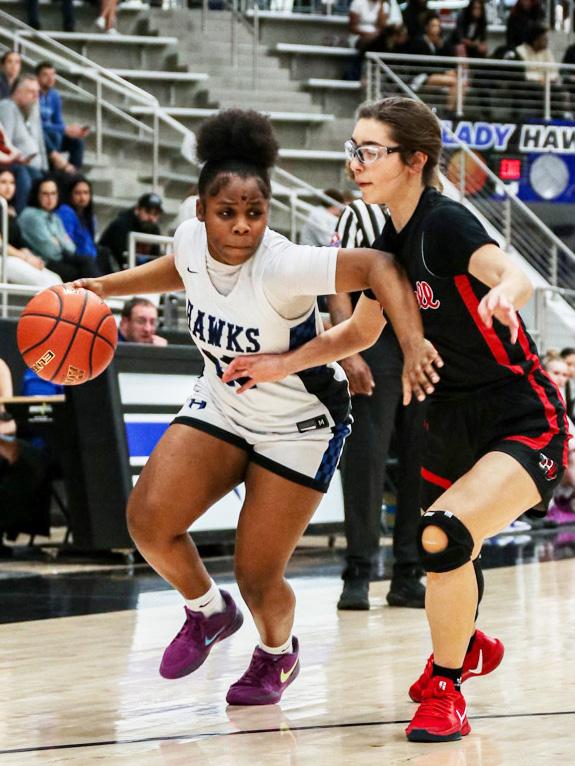
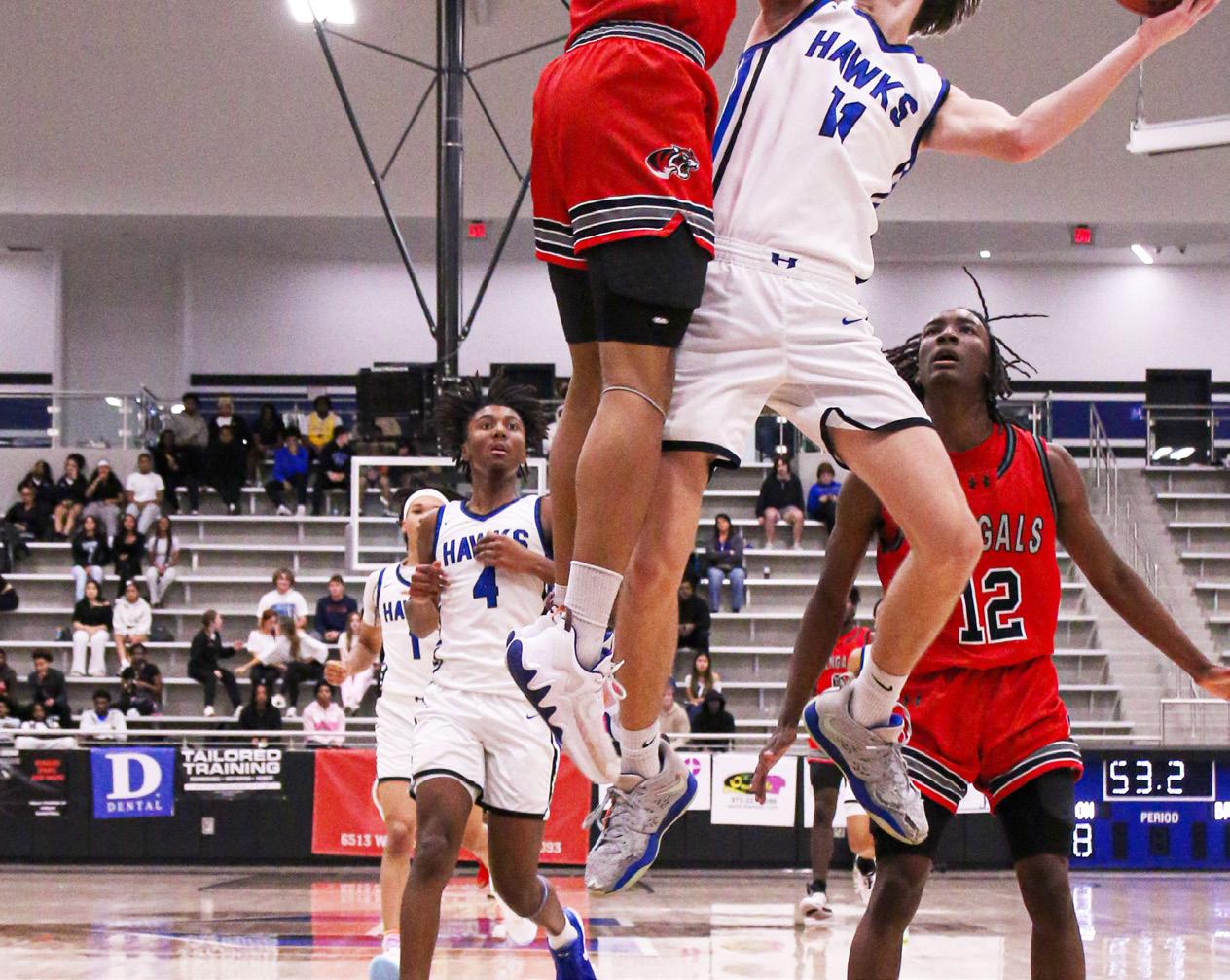
Guard Jake Pope goes up for a layup while a defender attempts to block the shot in a game against Braswell Jan. 31. Braswell got the rebound after Pope missed the shot, scoring on the subsequent possession. The Hawks trailed 32-21 to end the first half. (Photo by Joshua Thomas.)
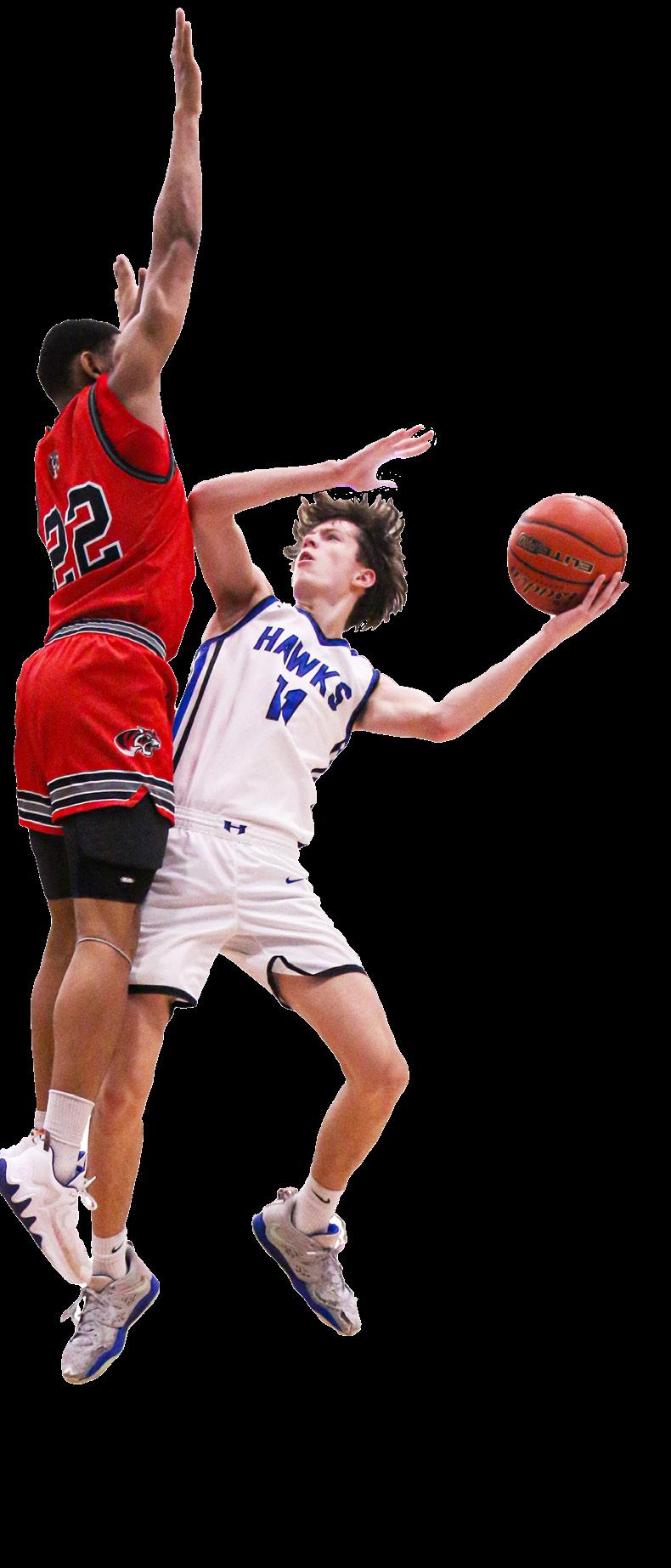
Guard Nariah Johnson drives the ball against a Braswell defender during the second quarter. Johnson failed to convert on the following layup attempt. (Photo by Gavin Lambert.)
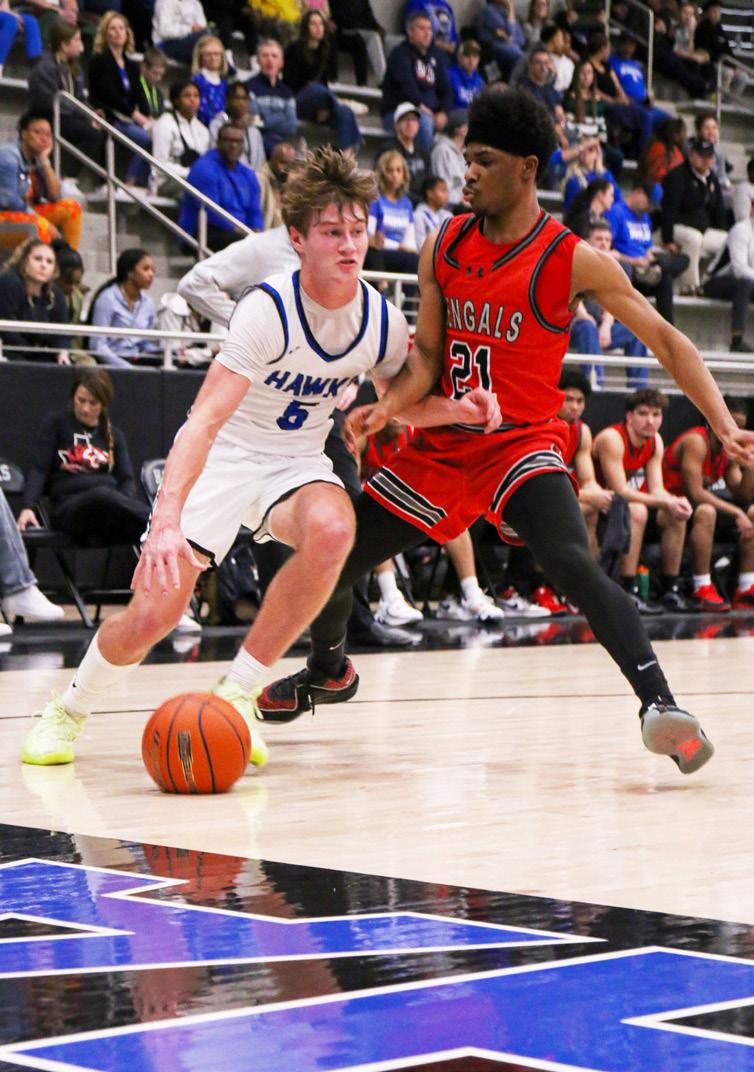
Guard Tyler Hoke drives past a defender in the second quarter. Hoke was double teamed by two defenders, where he

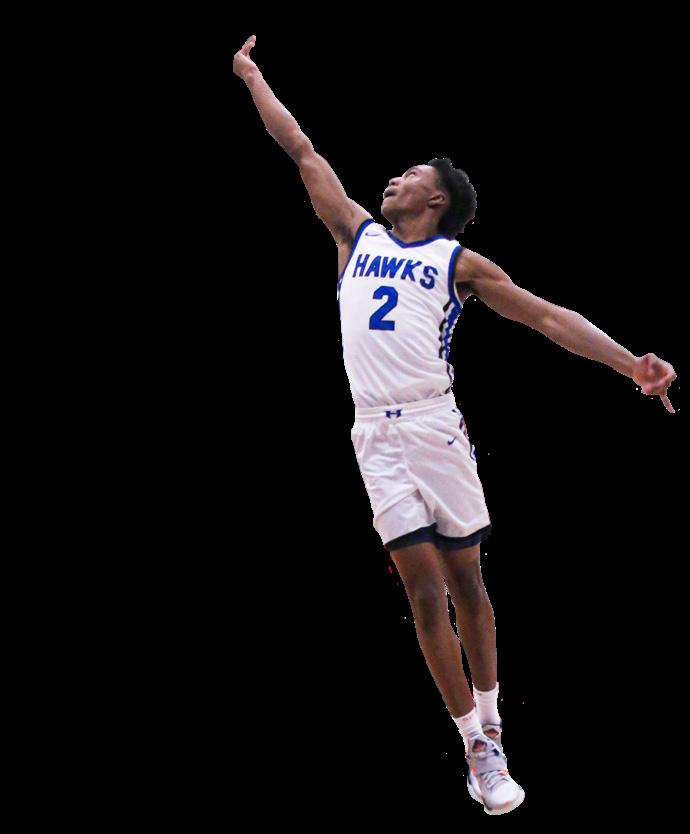
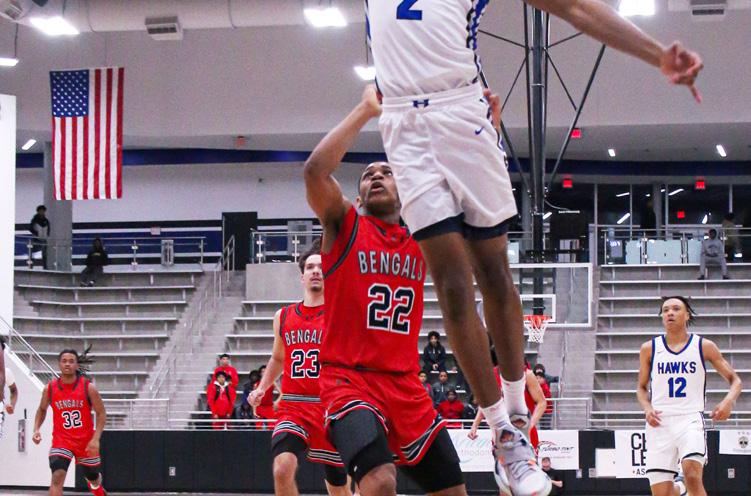
Guard Randy Hemphill attempts a fast-break layup late in the fourth quarter. Hemphill made the shot, as the Hawks trailed 58-37. (Photo by Joshua Thomas.)
Guard Brooke Thomas drives the ball through the Braswell defense in the third quarter. Thomas was the teams second leading scorer in the game, finishing with five points. (Photo by Gavin Lambert.)

Head coach Lisa Branch draws up a play during a timeout in the first quarter of the teams game against Braswell on Jan. 31. The team led 10-9 at the end of the quarter, yet the team went on to lose the game 46-27. (Photo by Gavin Lambert.)

Bolden drives the ball against a Braswell defender in the second quarter. Bolden finished the game as the team’s leading scorer with 15 points. (Photo by Gavin Lambert.)


Story by SHiren noorani
I met my younger self for coffee this morning. She was 10 minutes late. I was 10 minutes early. I drive myself now, so I’m in charge of my own time.
She wore her short, straight hair back with a sports headband. I wore my long, wavy hair naturally — it’s my favorite style.
She ordered a hot chocolate; I ordered refresher. She never tried coffee; I drink coffee when I crave it, but usually stick to a refresher. She loved the sweetness of the hot chocolate, but I find it important to watch what I eat and drink.
She wore her favorite black Nike basketball shorts with her favorite gray Dallas Cowboys t-shirt. I wore an Alo matching sweatsuit. I still love the Dallas Cowboys, but the shirt now collects dust.
She wore her beaded friendship bracelet on her left hand with her gatpat dhaga (religious bracelet) on her right. I wore my three silver bracelets — my permanent bracelet, my Tiffany & Co. bracelet and the bracelet that my best friend got me for my 17th birthday — on my left hand, with my gatpat dhaga still on my right.
She told me she was struggling to finish an essay for school. I told her I’m a writer now. She asked me what I could possibly write about. I told her I find peace in writing about the people I love and the experiences that have shaped me.
She told me she was late because she couldn’t skip her daily “chucker” (drive around the neighbor hood) with Dada (grandpa).
I smiled and said “Me too.” I didn’t have the heart to tell her I go on “chuckers” by myself after each time that I visit his grave.
She told me her cousins kept strangling her with hugs. I told her to hold onto them even tighter. She questioned why I was focused on telling her to not take things for granted. I told her all that I have lost.
She told me Dada’s waiting outside in the car. I told her how I learned how to drive in his car after he passed away. She asked me how I can live in a world without him. I told her about all the people who entered my life when he left it. Even though he isn’t physically here, I find him in the little things.
She told me Nanu (grandma) was on bed-rest due to a car accident in Houston. I told her Nanu is the first person to ask me how my day is when I get home from school.
She told me her parents teased her for crying about everything. I told her I rarely cry in front of people now.
She told me her cousin’s boyfriend called her “she she” as a nickname. I told her his 2-year-old son calls me that, but he can’t make the “sh” sound so it sounds more like “tee tee.”
those around me first.
She told me she didn’t know who her real friends were because she doesn’t feel worthy of anyone. I handed her my phone and showed her my wallpaper filled with the people who love me back. I told her they don’t care about what I can do for them, they just love me for who I am.
She told me our grandma feeds her eggs for breakfast every morning. I told her I skip breakfast, but every time I eat eggs, it’s still from our grandma’s hands.
She wondered how I made it this far. I told her to hold on a little longer and she’d find her reason.
She told me she had to go home. I told her home is the people we love, not the walls we call a house.
We hugged; it was awkward. She hated hugs. I love them from the right people. As she walked out of the coffee shop, she waved goodbye without a second glance.
She won’t think about me often; I think about her every day.
I hope we meet for coffee again.

She told me she doesn’t understand the airplane oxygen mask rule: put your own mask on before helping others. I told her I understand it, but will always make the conscious decision of helping
My mom was cooking spaghetti in the kitchen while my dad and I sat on the couch, FaceTiming my grandmother.
I didn’t want to talk to her. It wasn’t because I didn’t love her — I just didn’t want to see the fabric that covered her shaved head. I didn’t want to see the colorless walls of the hospital room. I didn’t want to see her used-to-be-tan skin, now sickly pale.
I should have talked to her more that night, because it was the last time I ever would.
The following days, we got the call that she wasn’t going to make it much longer; her cancer was winning. The next morning, we packed up the car and made the drive to Houston to say goodbye.
I had just woken up from a nap during the long car ride. I looked up at my mom’s phone to see how far away we were: five minutes. I laid my head back down against the car door, still tired and sore from my COVID-19 vaccine the day before.
Then, everything went black. Someone ran a red light, crashing into the backseat door my head was leaning against.
Instead of spending my day in the hospital, saying goodbye to my grandmother, smelling her sweet scent and hearing her warm laughter one last time, I was the one lying in the hospital bed.
While I lay in the bed, tubes running in my arms and countlesss X-Rays and CT scans performed on me, she passed away. I never got the chance to say goodbye. Now that I am a senior — not the freshman girl my grandmother once knew — saying goodbye has become
inevitable. I used to pretend it wasn’t. If I just avoided the thought, maybe I wouldn’t lose my high school friends.
My grandmother taught me many important lessons when she was alive: save money to treat yourself, four leaf clovers are lucky and laughing is the most joyful part of life. The most important lesson, however, is to cherish memories while they last.
Story by Peyton kuSHmeider
Even though my grandmother was growing old, she never forgot anything. Every day, she had a new story to tell about her old friends or family members she hadn’t spoken to in years; no matter what happened between them, she never talked badly about anyone.














Throughout my last few months of high school, my goal is to be just like her.
In a few months, I will be in college. My closest friends will be states away and I won’t be living in my own home anymore. I am terrified of that day. I’m scared to lose contact with my friends and to not be able to see the same faces walking down the hallways every day.
I’m not going to avoid my friends because I know they’re leaving; instead, I’m going to breathe in every moment with them and carry those memories with me to share with my own grandchildren one day.
I used to run away from saying goodbye, but I have learned that doing that only leads


to regret. To end my last year of high school, I will take the lessons my grandmother left me with and not make the same mistakes I made with her.
For once, I won’t let myself be afraid of those goodbyes, but will cherish every moment and say my final farewells to many people.

story by krista fleming
There is nothing quite as stressful as planning for college.
The topic gets brought up what feels like a thousand times in one’s high school career. It’s an important thing to consider when planning a high school schedule, and one of the immediate questions asked on every first day of school. As a senior, the topic becomes even more daunting — the beginning of the year is a blur of applications, acceptances and filling out forms.
Later in the year, just as it all begins to slow down again, the stress of college rears its ugly head one last time: packing.
After experiencing the hazardous journey of packing for college three times with my siblings, I’ve devised the ultimate list of college essentials every senior should start planning for.
When my eldest sister went away for college, she only lasted one night before calling my mom. “It’s too hot,” she complained, even in New York. The AC was on, but, like every other college dorm, it was barely circulating. She ordered a fan by night three — just something small to add circulation to the room — and I haven’t heard her complain about the temperature since then.
One of the most important — and most often forgotten — things to bring to college is a long extension cord. A dorm room only has a handful of outlets, which will be needed to plug in technology, lamps and appliances. This makes 10-feet long extension cords all the more vital.
Having space is a luxury college students cannot afford. Most of the time, one’s closet is small and shared; it only fits half the clothes brought. This makes storage bins and drawer organizers crucial to maximizing space, whether it’s for sock storage or blankets. Options best suited for under the bed are optimal for conserving space.
The easiest way to make a dorm feel like home is to have proper lighting — not just the white fluorescents reminiscent of a hospital room. Getting a desk lamp for late-night work allows better flexibility with roommates, but lighting from fairy lights or LEDs help just as much with improving the vibes of the room.
Every person I know that’s gone to college has complained about the bathroom. Whether sharing a communal bathroom with everyone or just with three other people, a mirror to oneself can be a rarity. This makes a mini mirror all the more important, especially when it comes within a makeup bag or small enough to be put away.

story by staff
Six years.
The basic allotment — the main source of funding for public education — stagnated six years ago. Inflation has risen 20% and Texas legislators have set aside funds specifically for public schools, but districts have yet to see a cent of the $4 billion.
During the 89th legislative session, legislators should add more funds and distribute them to make better education accessible, taught well and maintain any chance at a substantial future.
Public education is public for a reason — everyone should have access to a wellrounded
education. LISD’s budget for this fiscal year includes a $4.5 million deficit, and school districts across Texas face similar problems, with over half of the 53 North Texas districts reporting budget deficits. Legislators should increase funding to accommodate these public school districts. Not every student can afford private school tuition if their public school is struggling to keep the lights on or water running, much less provide quality education. Increased funding is also a necessity to give teachers livable wages. This is an issue across the nation, but Texas educators earn over $9,000 less than the national average and 65% of Texas teachers seriously considered leaving the profession last year. If the legislative session fails to deliver meaningful teacher raises like it did in the 88th legislative session, teachers could act on those thoughts. The state needs quality educators to give students a quality education; that can’t happen without quality funding.
These numbers and statistics are not just school districts being over dramatic — they’re a cry for help from the state’s future. Only 6% of students in the state go to private school, leaving 94% of students to flounder about if public education declines. These are future doctors, lawyers and politicians relying on basic education. Failing to fund them means failing to fund the future.
If the state sees problems with public education, it should not solve them by sending kids elsewhere, as is the goal with the proposed education savings accounts. This proposal will give vouchers to help accommodate parents who wish to send their children to private school. If legislators believe that public education is worse than private education, they should invest in making public schools better, rather than ignoring the issues and sending students away.
Besides just distributing the $4 billion from the last legislative session, the legislators should increase the basic allotment from $6,160 per student to at least match inflation. Public education needs funding — now more than ever. Students, parents and teachers should call their representatives and share their voice. Students are the future, and if the legislators being voted into power can’t see that, then Texas’ future will grow bleaker by the day.

Story by Siya Patel
As it’s getting closer to the end of my junior year, I have been both excited and nervous. Coming-of-age movies have that same feel, making them exactly what I want to watch. Here is a ranking of my top five favorite movies of the genre.
5. Sixteen Candles (1984)
“That’s why they call them crushes. If they were easy, they’d call them something else.”
This film is a classic 80s teenage rom-com. It follows Samantha (Molly Ringwald) as her family forgets her big 16th birthday. The film captures the awkwardness of high school romance as well as experiencing adolescent dread — which can be relatable. While nostalgic, it lacks the emotional depth and cultural relevance of the other movies. Some problematic elements also make it harder to fully enjoy.
4. The Breakfast Club (1985)
“We’re all pretty bizarre. Some of us are just better at hiding it, that’s all.”
This is a classic teen movie that defined a generation. The story follows five high school students, each representing a cliche stereotype, through a Saturday detention. They spend time understanding each other and leave the detention wondering if school will be the same after their shared experience. It’s a funny, emotional and iconic movie that everyone should watch at least once in their life.
3. The Hate U Give (2018)
“What’s the point of having a voice if you’re going to be silent in those moments you shouldn’t be?”
This is a powerful and sociallyrelevant film about race, police brutality and personal identity. The movie follows Starr Carter (Amandla Stenberg), a young girl caught between two worlds. But the balance between the two worlds is torn apart when she witnesses her friend being shot by a police officer. The film managed to effectively balance emotional storytelling with a strong message. The real world relevance ensured its spot on this ranking.
2. The Perks of Being a Wallflower (2012)
“We accept the love we think we deserve.”
This coming-of-age film is heartfelt, raw and genuinely relatable. The movie follows Charlie (Logan Lerman), a shy 15-year old who has just entered high school. He becomes friends with seniors Sam (Emma Watson) and Patrick (Ezra Miller), but soon has to deal with his past and the idea of his new friends graduating. This film encapsulates the struggles of mental health, trauma and loneliness with sensitivity. The mix of deep emotions and nostalgia makes it a must-watch.
1. Dead Poets Society (1989)
“Carpe diem. Seize the day, boys. Make your lives extraordinary.”
This film is an emotional and inspiring masterpiece, with themes of individuality and passion. The movie follows John Keating (Robin Williams), a new English teacher who encourages his students to think for themselves at a school known for upholding old standards. He uses unique methods to reach out to each student. The film’s timeless message and emotional depth make it stand out and cements its place as the best on this list.
Story by Siya Patel
Prom is all about two things: glitz and glamour.
Every teenage girl has dreamed about her prom — spending the night partying with friends while looking their absolute best. To ensure a stress-free day, here are ways to prepare for prom.
Watching my sister go through her own prom experience, one thing I won’t be doing is waiting until the last minute to find an outfit. The scrambled efforts were unnecessary and easily preventable. Planning your outfit in advance reduces the likelihood of a stressful impromptu shopping trip. It allows ample time to find accessories to match your clothing of choice, while giving you the option to make changes later if necessary. Having an outfit prepared means one less thing to think about as the day comes near.
Whether you’re attending with your friends or significant other, you can plan ahead. Plan matching outfits and figure out items like corsages. By coordinating with your date ahead of time, you have a plan in place for the day while leaving room for potential changes.
As you’re dressed to look your absolute best, pictures are a must. It’s a way to capture memories and have something to look back on.
To ensure the photos come out looking just as you want, it’s a good idea to have locations in mind. You can put plans together with friends and parents to guarantee the photo shoot runs smoothly.
One item people tend to forget is transportation. Consider if you’re planning on showing up with your friends, your date or on your own. Decide whether you are going to carpool, drive or even order a limo or party bus. By having a mode of transportation in place, you’ll get to your location stress free.
Make dinner reservations
Before a night full of dancing, it’s a good idea to fill up on food. While prom has much to it, dinner is not included. Making plans to go out for dinner with your friends before the dance makes for a fun activity before the exciting chaos of prom. By making reservations ahead of time, there is one less thing to worry about the day of.
3/4 away vS. lewiSville
3/7 Home vS. braSwell
3/17 away vS. Flower mound
3/4 away vS. lewiSville
3/7 Home vS. braSwell
3/17 away vS. Flower mound
3/6 Home vS. lewiSville
3/12 away vS. Coppell
3/14 Home vS. Coppell
3/15 Home vS. lone Star
3/18 Home vS. marCuS
3/1 away vS. argyle
3/5 away vS. Coppell
3/8 Home vS. marCuS
3/10 Home vS. guyer
3/13 away vS. little elm
3/18 Home vS. lewiSville
3/21 away vS. braSwell
3/28 Home vS. Coppell : : : : :
3/25 Home vS. Flower mound
3/21 away vS. marCuS 3/10-3/14